一、AJAX简介
AJAX(Asynchronous Javascript And XML)翻译成中文就是“异步Javascript和XML”。即使用Javascript语言与服务器进行异步交互,传输的数据为XML(当然,传输的数据不只是XML)。
- 同步交互:客户端发出一个请求后,需要等待服务器响应结束后,才能发出第二个请求;
- 异步交互:客户端发出一个请求后,无需等待服务器响应结束,就可以发出第二个请求。
AJAX除了异步的特点外,还有一个就是:浏览器页面局部刷新;(这一特点给用户的感受是在不知不觉中完成请求和响应过程)
向服务器发送请求的途径:
1.浏览器地址栏,默认get请求;
2.form表单:
get请求
post请求
3.a标签,超链接(get请求)
4.Ajax请求
特点:1异步请求;2局部刷新
get
post
场景:
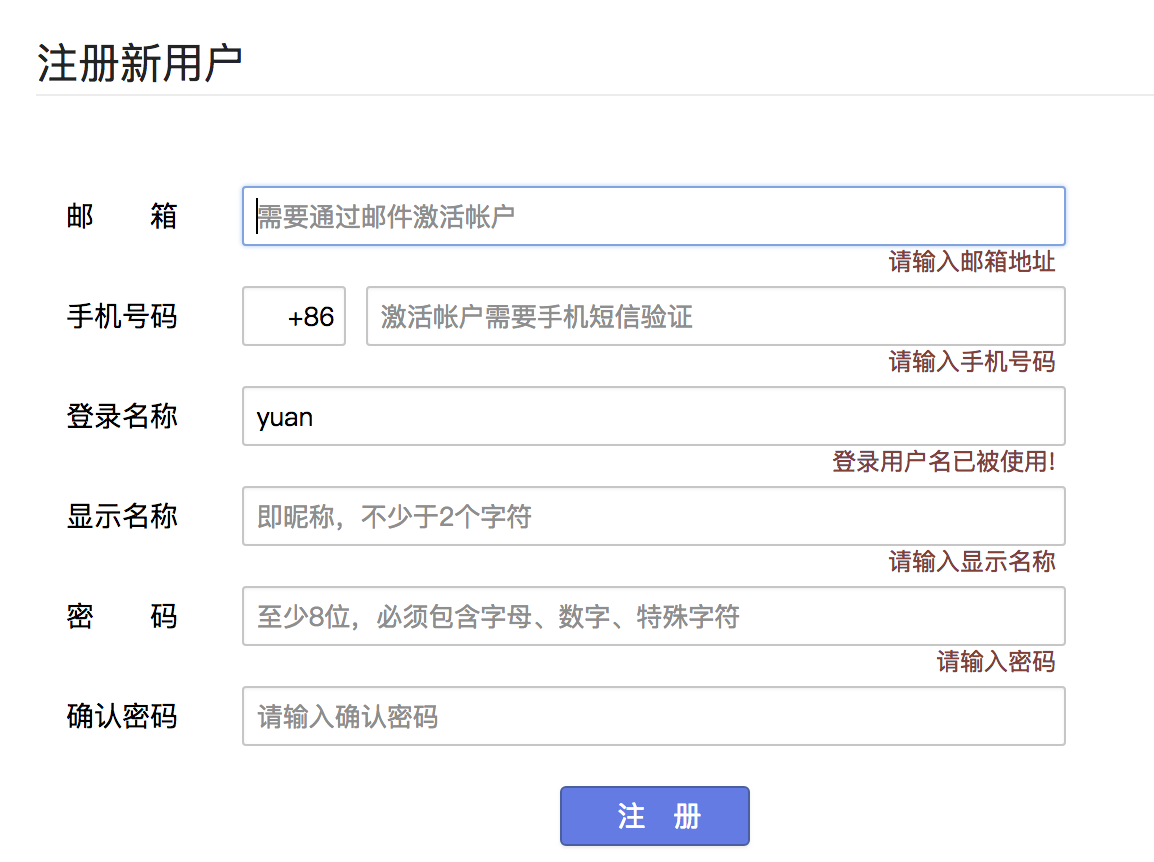
优点:
- AJAX使用Javascript技术向服务器发送异步请求
- AJAX无须刷新整个页面
二、基于jquery的Ajax实现
index.html
<!DOCTYPE html> <html lang="en"> <head> <meta charset="UTF-8"> <title>Title</title> {# 引入jquery#} <script src="https://code.jquery.com/jquery-3.3.1.min.js"></script> </head> <body> <h2>this is Index</h2> <button class="Ajax">Ajax</button> <p class="content"></p> <script> $(".Ajax").click(function () { // alert(123) // 发送Ajax请求 $.ajax({ url:"/test_ajax/", // 请求url // 没有加ip地址和端口会默认找当前脚本对应的ip地址和端口 type:"get", // 请求方式post data:{a:1,b:2}, // 不是字典,是object success:function (data) { // 回调函数,某个事件执行完之后再去执行的函数
console.log(data);
$(".content").html(data);
}
});
});
</script>
</body>
</html>
view.py
# -*- encoding:utf-8 -*- from django.shortcuts import render,HttpResponse # Create your views here. from app01.models import User def index(request): return render(request,"index.html") def test_ajax(request): print(request.GET) return HttpResponse("hello mm")
Ajax---服务器 Ajax流程图
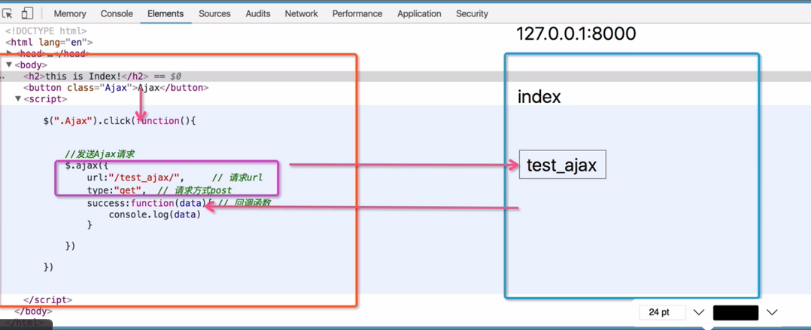
执行过程:
一点击Ajax按钮,触发click这个函数,然后发就要发生ajax,给test_ajax发Ajax路径请求,当url匹配成功后,它把这次请求的结果交给了data,(在test_ajax里返回了一个hello mm的字符串)刚刚那个hello mm这个字符串就交给了data(data拿到结果);然后再执行那个回调函数能够打印,用js处理data. (在页面中加上节点)

三、Ajax数据传递
urls.py
from django.contrib import admin from django.urls import path from app01 import views urlpatterns = [ path('admin/', admin.site.urls), path('index/', views.index), path('test_ajax/', views.test_ajax), path('cal/', views.cal), ]
views.py
# -*- encoding:utf-8 -*- from django.shortcuts import render,HttpResponse # Create your views here. from app01.models import User def index(request): return render(request,"index.html") def test_ajax(request): #这次请求在处理ajax请求, print(request.GET) #拿到数据,去处理 return HttpResponse("hello mm") #根据数据给回调函数返回个什么参数 def cal(request): print(request.GET) a = int(request.GET.get("a")) #取出这两个值 b = int(request.GET.get("b")) print(a) print(b) c = a + b #计算下 print(c) return HttpResponse(c)
index.html
<!DOCTYPE html> <html lang="en"> <head> <meta charset="UTF-8"> <title>Title</title> {# 引入jquery#} <script src="https://code.jquery.com/jquery-3.3.1.min.js"></script> </head> <body> <h2>this is Index</h2> <button class="Ajax">Ajax</button> <p class="content"></p> <hr> <input type="text" id="t1">+<input type="text" id="t2">=<input type="text" id="t3"> <button class="cal">计算</button> <script> $(".Ajax").click(function () { // alert(123) // 发送Ajax请求 $.ajax({ url:"/test_ajax/", // 请求url // 没有加ip地址和端口会默认找当前脚本对应的ip地址和端口 type:"get", // 请求方式post data:{a:1,b:2}, // 不是字典,是object success:function (data) { // 回调函数 console.log(data); $(".content").html(data); } }); }); // Ajax计算求值 $(".cal").click(function () { $.ajax({ url:"/cal/", type:"get", data:{a:$("#t1").val(),b:$("#t2").val()}, success:function (data) { $("#t3").val(data); console.log(data) } }) }); ///////////////form表单一定要有input标签放有效控件,action发送路径,method是请求方式;数据由input type="text"里边的内容决定;键就是name指定的值, 一点submit按钮就会给你自动组装这两个键值,通过method指定的方式发给action指定的路径 <form action="" method=""> <input type="text", name="user"> <input type="text", name="pwd"> </form> /////////////////// </script> </body> </html>
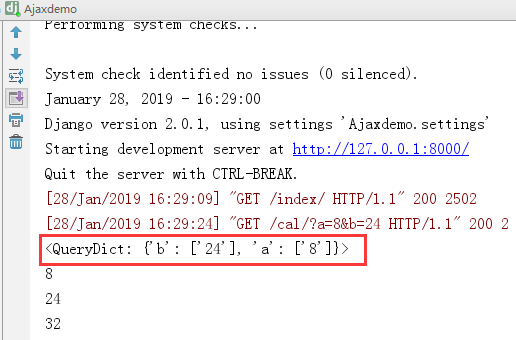

四、基于Ajax的登录验证
用户在表单输入用户名与密码,通过Ajax提交给服务器,服务器验证后返回响应信息,客户端通过响应信息确定是否登录成功,成功,则跳转到首页,否则,在页面上显示相应的错误信息。
models.py
from django.db import models # Create your models here. class User(models.Model): name = models.CharField(max_length=32) pwd = models.CharField(max_length=32)
views.py
# -*- encoding:utf-8 -*- from django.shortcuts import render,HttpResponse # Create your views here. from app01.models import User def login(request): print(request.POST) user = request.POST.get("user") pwd = request.POST.get("pwd") res={"user":None,"msg":None} #user默认是None,有值肯定是登录成功了; "msg"是避免出现错误信息,错误信息是什么 user_obj = User.objects.filter(name=user,pwd=pwd).first() print(user_obj) if user_obj: res["user"] = user_obj.name else: res["msg"] = "username or password wrong!" #失败了给msg赋个值 import json #想把res这个字典交给data,HttpResponse里边必须放字符串, return HttpResponse(json.dumps(res)) #序列化下,json字符串 。
index.html
<!DOCTYPE html> <html lang="en"> <head> <meta charset="UTF-8"> <title>Title</title> {# 引入jquery#} <script src="https://code.jquery.com/jquery-3.3.1.min.js"></script> </head> <body> <form > 用户名 <input type="text" id="user"> 密码 <input type="password" id="pwd"> //下面是button只是一个按钮;改成submit就会组成键值对发过去,就是form表单请求了。 <input type="button" value="submit" class="login_btn"> <span class="err"></span> </form> <script> // 登录验证 $(".login_btn").click(function () { $.ajax({ url:"/login/", type:"post", data:{ user:$("#user").val(), pwd:$("#pwd").val() }, success:function (data) { console.log(data); // json字符串,js再给它反序列化拿到它支持的类似字典的object类型。 console.log(typeof data); var data = JSON.parse(data); //js再用它自己的json方法给它反序列化成字典 object{};js这个语言反序列化的方法是json.parse console.log(data); // 反序列化类似字典的object console.log(typeof data); if(data.user){ //有值登录成功了就让它跳转下 location.href = "/login_success/" } else{ //html文本赋值(错误信息值) $(".err").html(data.msg).css({"color":"red","margin-left":"20px"}) } } }) }) </script> </body> </html>
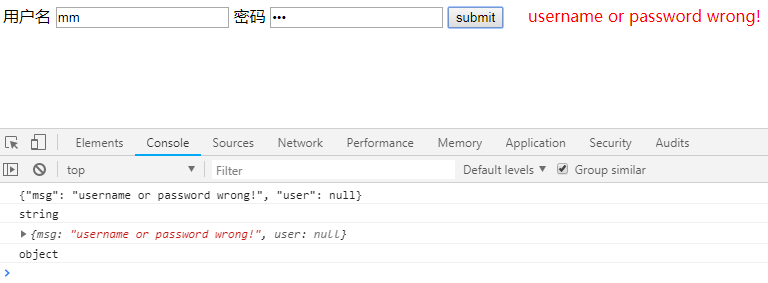
五、上传文件
5.1基于form表单上传文件
views.py
def file_put(request): if request.method == "POST": print("POST",request.POST) # POST <QueryDict: {'user': ['mm']}> print("FILES",request.FILES) # 上传成功的文件 FILES <MultiValueDict: {'imgs': [<InMemoryUploadedFile: kobe.jpg (image/jpeg)>]} file_obj = request.FILES.get("imgs") # 文件对象 with open(file_obj.name,"wb") as f: # #上传的文件名file_obj.name 会把这个文件存到跟目录下 for line in file_obj: f.write(line) return HttpResponse("上传成功!") return render(request,"file_put.html")
file_put.html
<!DOCTYPE html> <html lang="en"> <head> <meta charset="UTF-8"> <title>Title</title> </head> <body> <h3>基于form表单的文件上传</h3> <form action="" method="post" enctype="multipart/form-data"> //上传文件一定要加上这个 用户名 <input type="text" name="user"> 图像 <input type="file" name="imgs" > <input type="submit"> </form> </body> </html>


5.2 请求头ContentType:urlencoed
都在这个字符串报文里边(请求首行、请求头、请求体):
请求首行
请求头(决定数据以什么格式进行编码)
....
ContentType:urlencoed(告诉服务器,这次发过来的请求体的数据是按照urlencoed这种格式进行编码的(a=1&b=2..))
请求体(a=1&b=2&c=3)
服务器那边拿到这个wsgiref先检查ContentType,如果是urlencoed它就知道你是怎么编码的了,它就按照这种方式解码,拿到相应的键以及对应的值。
enctype="multipart/form-data"是另外一种编码格式,文件可以用这种方式;而普通的键值只适用这种 enctype="application/x-www-form-urlencoded" 编码格式
enctype="multipart/form-data" #上传文件一定要加上这个
enctype="application/x-www-form-urlencoded" #普通的键值对的上传加这个
file_put.html
<!DOCTYPE html> <html lang="en"> <head> <meta charset="UTF-8"> <title>Title</title> <script src="http://ajax.aspnetcdn.com/ajax/jquery/jquery-2.1.4.min.js"></script> </head> <body> <h3>简单的form</h3> <form action="" method="post" enctype="application/x-www-form-urlencoded"> {#普通的键值只能用这种#} 用户名<input type="text" name="user"> 密码<input type="password" name="pwd"> <input type="submit"> </form> <h3>基于form表单的文件上传</h3> <form action="" method="post" enctype="multipart/form-data"> 用户名<input type="text" name="user"> 头像<input type="file" name="avatar"> <input type="submit"> </form> <h3>基于Ajax文件上传</h3> <form action="" method="post"> 用户名<input type="text" name="user"> <input type="button" class="btn" value="Ajax"> </form> <script> $.ajax({ url:"", type:"post", data:{ a:1, b:2 },//无论是ajax还是form它们都有一个默认的请求头ContentType:urlencoed ,把我们写好的数据按照某种类型编码好之后放到请求体中,然后把整个报文部分发给服务器 success: function (data) { console.log(data) } }) </script> </body> </html>
5.3 Ajax传递json数据
file_put.html
<h3>基于Ajax文件上传</h3> <form action="" method="post"> 用户名<input type="text" name="user"> <input type="button" class="btn" value="Ajax"> </form> <script> $(".btn").click(function()){ $.ajax({ url:"", type:"post", contentType:"application/json", //不加它默认是contentType:urlencoed;加上application/json相当于是告诉服务器这次编码类型是json数据了 data:JSON.stringify({ #对一个数据进行序列化,相当于python里边的json.dumps,把这个a:1,b:2数据放到stringify里边,它对应的值就是json字符串 a:1, //告诉服务器这次发的是json数据你到时候按照json解就可以了 b:2 }), //无论是ajax还是form它们都有一个默认的请求头ContentType:urlencoed ,把我们写好的数据按照某种类型编码好之后放到请求体中,然后把整个报文部分发给服务器 success: function (data) { console.log(data) } }); }); </script>
请求首行 请求头(决定数据以什么格式进行编码) .... ContentType:json #urlencoed(告诉服务器,这次发过来的请求体的数据是按照urlencoed这种格式进行编码的(a=1&b=2..)) 请求体{"a":"1", "b":"2"} #到时候反序列化就可以了 #(a=1&b=2&c=3)
views.py
def file_put(request): if request.method == "POST": print("body",request.body) #请求报文中的请求体 body b'{"a":1,"b":2}' 取的时候进行解码,反序列化就可以了;a=1&b=2在请求体里边,所以能打印出 print("post",request.POST) #用户上传的数据;post <QueryDict: {}> 只有在ContentType:urlencoed时,request.POST才有数据,数据存到body里边了 return HttpResponse("ok") return render(request, "file_put.html") ''' 请求首行 请求体 ''' ''' ContentType:urlencoed 请求头 这样的编码格式 ;multipart/form-data文件上传只能用这种 请求体(a=1&b=2&c=3) '''
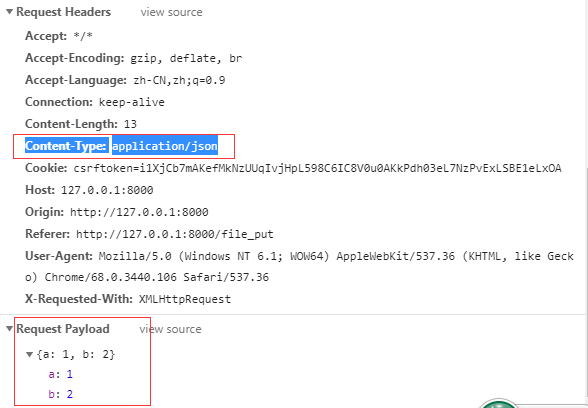
############如果把这些都去掉,对比上边的
$(".btn").click(function()){
$.ajax({
url:"",
type:"post",
###contentType:"application/json", contentType:urlencoed;//把这些都去掉
data:{
a:1,
b:2
},
success: function (data) {
console.log(data)
}
});
});
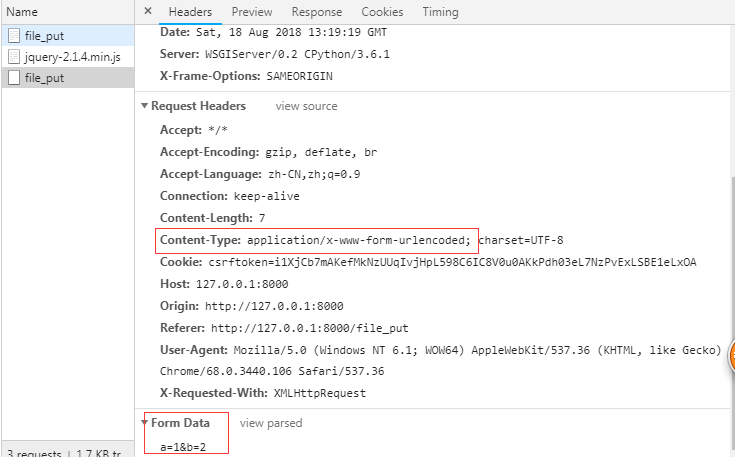

post是按照body解成的字典,只有urlencoded这种编码格式才会给你解;json不会给你解,必须去request.body里边去取自己去拿原生的数据,自己去进行反序列化。
5.4 基于Ajax文件上传
这里data不光是写个字典了,上传文件要把 enctype="multipart/form-data"格式换成这种编码格式来上传数据;如果没有文件上传,就像之前那样子写data的键值对;
一旦涉及上传文件,创建一个formdata的对象
file_put.html
$(".btn").click(function () {
var formdata = new FormData();
formdata.append("user",$("#user").val()); {#不断的append添加键值对#}
formdata.append("imgs",$("#imgs")[0].files[0]);
$.ajax({
url:"",
type:"post",
// 报错:Uncaught TypeError: Illegal invocation,需加上下面两行
// 加2个参数,只要有formdata就要有这两个参数。意思是不做编码了,对文件不做处理。
contentType:false,
processData:false,
data:formdata, //把整个formdata对象放到data里边
success:function (data) {
console.log(data)
}
})
})
view.py
def file_put(request): if request.method == "POST": print("body",request.body) #请求报文中的请求体 print("POST",request.POST) #用户上传的数据; 只有在ContentType:urlencoed时,request.POST才有数据 print("FILES",request.FILES) # 上传成功的文件 file_obj = request.FILES.get("imgs") # 文件对象 with open(file_obj.name,"wb") as f: #上传的文件名file_obj.name for line in file_obj: f.write(line) return HttpResponse("上传成功!") return render(request,"file_put.html")

用 js 怎么来找到这个文件呢?通过找到对应的input标签 dom对象,然后[0]来获取文件
